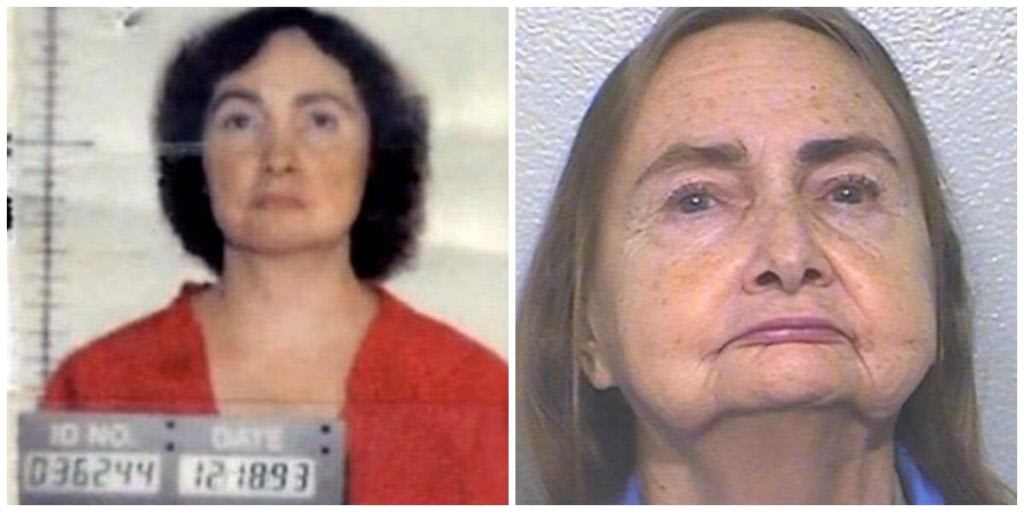The Most Evil Mother in America: The Harrowing Life of Teresa Knorr
The Unbelievable Crimes and Dark History of Teresa Knorr, America's Most Evil Mother

Teresa Knorr is a name that sends chills down the spine of anyone familiar with her story. Dubbed "The Most Evil Mother in America," Teresa's life was a series of horrific abuses, manipulations, and murders that left a lasting scar on her family and shocked the nation.
Early Life and Family Struggles
Teresa Jimmy Francine Cross was born on March 12, 1946, in Sacramento, California, to her parents, Swanny and Jim Cross. Teresa was the youngest of four children. Her mother had two children from a previous marriage, a boy named William and a girl named Clara. Jim, Swanny's new husband, completely took these two kids under his wing, treating them as if they were his own. Together, Swanny and Jim had two children: a daughter named Rosemary and Teresa, making it a family of six.
Jim worked as a cheese maker, while Swanny was employed at a local timber company. Having two incomes in the household meant that they were relatively well-off compared to the rest of their neighborhood. In the 1950s, they bought a big house in Sacramento and seemed to live a normal, happy life.
Family Turmoil and Loss
However, things began to unravel in the late 1950s when Jim was diagnosed with Parkinson's disease. This condition causes severe, uncontrollable shaking, making it difficult for sufferers to perform even simple tasks. As Jim's condition worsened, he had to leave his job as a cheese maker because he could no longer physically handle the work. His disease became increasingly debilitating, confining him to the house. Jim's inability to participate in family life led to severe depression, which manifested as resentment toward his family, who could still go out and live their lives.
Swanny, now the sole breadwinner, had to take on more hours at work to support the family, leaving the children to bear the brunt of Jim's anger. The stress of her husband's illness and the increased responsibilities took a toll on Swanny. She became exhausted, struggling to keep up with the demands of her job and caring for her family. The situation reached a tragic climax in March 1961 when Swanny suddenly collapsed and died of congestive heart failure while out shopping with Teresa.
Tumultuous Relationships and Marriages
The sudden loss of her mother deeply traumatized Teresa, leaving her to essentially rear herself as her father became increasingly incapacitated by his illness. Teresa's life took a dark turn as she fell into a deep depression, which manifested as anger and isolation from her family. She met her first boyfriend, Clifford Sanders, at around 15 years old, and they were married within three months. The relationship was tumultuous, marked by Teresa's emotional dependency and abusive behavior.
Teresa's behavior towards Clifford was possessive and controlling. She constantly accused him of infidelity and often lashed out in fits of jealousy. Clifford, unable to cope with her increasingly erratic behavior, threatened to leave her. In a desperate attempt to prevent this, Teresa shot and killed him in 1964. She claimed the shooting was accidental, but evidence suggested otherwise. Surprisingly, she was acquitted of the murder, partly due to the revelation that she was pregnant with Clifford's child. She gave birth to Sheila Sanders shortly after.
Teresa's subsequent relationships followed a similar pattern of abuse and turmoil. She entered a relationship with Estelle Thornberry, a paralyzed U.S. Army veteran, which was also marked by manipulation and violence. Teresa's manipulative and violent behavior continued through several more relationships and marriages, each marked by domestic turmoil and abuse. She had six children in total: Howard, Sheila, Susan, William, Robert, and Terry.
Escalating Abuse and Isolation
The abuse Teresa inflicted on her children was severe and escalated over time. After divorcing her third husband, Chester Harris, who had been a supportive stepfather, Teresa's mental health deteriorated further. She became increasingly reclusive and paranoid, cutting off contact with the outside world and subjecting her children to horrific abuse. Teresa's paranoia led her to isolate her family from the outside world, disconnecting the phone and forbidding visitors.
The family's living conditions deteriorated as Teresa's mental state worsened. She moved the family into a one-bedroom apartment, forcing her six children to live in cramped and unsanitary conditions. Teresa's abuse was both physical and psychological. She routinely beat her children, often using objects like belts and hangers, and subjected them to cruel punishments. Her daughters, Susan and Sheila, faced the brunt of her wrath.
Teresa's methods of abuse were brutal and unpredictable. She would throw things at her children, sometimes even knives, creating an environment of constant fear. The kids were always on edge, never knowing what Teresa might do next. She administered random beatings and, over time, the abuse only got worse.
Teresa soon started turning the children against each other. When she couldn't be bothered to abuse them herself, she would make them do it to each other. She would get them to pin each other down while she beat them. On one particularly awful occasion, she got all four of the older children to pin down the youngest, Terry. Teresa went and got a gun, putting it to Terry's head, and told her that if she didn't start behaving, she would kill her.
Teresa also neglected her children's basic needs. They were never allowed to go to the doctors or the dentist, even when they had illnesses or required medical attention. She didn't feed them properly, as most of her money was spent on alcohol. She made all her children drop out of school; none of them made it past eighth grade. Teresa didn't care that they wouldn't have qualifications; she didn't want the kids to have lives outside of her abusive household.
The Tragic Fate of Susan Knorr
Teresa's eldest daughters, Susan and Sheila, bore the brunt of her wrath. Teresa force-fed them to make them gain weight and beat them severely. Susan, who tried to run away, was eventually bound and kept under a kitchen table for two years, subjected to starvation and torture. In a particularly brutal incident, Susan was shot in the back, allegedly by her sister Terry, under Teresa's orders. Despite the severe infection and malnutrition, Susan survived but remained imprisoned under the table.
In 1984, Susan was taken by Teresa and her sons, William and Robert, to an isolated location where she was set on fire while still alive. Susan's body was discovered, but she was only identified as a Jane Doe due to the lack of dental records.
Sheila Knorr's Suffering
Sheila faced a similar fate. Forced into prostitution by her mother, Sheila contracted an STI, which Teresa blamed for her own infection. Sheila was confined to a tiny cupboard, deprived of food and water, and subjected to severe abuse. She eventually died from the conditions, and her body was also disposed of in a remote area. Like Susan, Sheila remained unidentified until much later.
The Escape and Revelation
The turning point came when Teresa's youngest daughter, Terry, managed to escape and sought help. After years of being dismissed by authorities, Terry's persistence paid off when she contacted the show "America's Most Wanted," leading to a renewed investigation. Her DNA matched that of the unidentified bodies of Susan and Sheila, finally bringing their true identities to light.
Terry's escape was a significant breakthrough in the case. She had managed to survive years of abuse and manipulation and had the courage to come forward with her story. Terry's detailed account of the abuse and the deaths of her sisters provided investigators with the crucial information they needed to pursue justice.
The Investigation
The investigation into Teresa Knorr's crimes was extensive. Detectives reviewed years of missing persons reports, cold cases, and forensic evidence. They uncovered a pattern of abuse and murder that spanned over a decade. Terry's testimony was corroborated by physical evidence, including the remains of Susan and Sheila.
Investigators also found that Teresa had a history of manipulating and controlling her children. She had forced them to participate in the abuse of their siblings, making them complicit in her crimes. This manipulation extended to her sons, William and Robert, who had helped dispose of Susan and Sheila's bodies out of fear for their own lives.
The Arrest and Trial
Teresa was eventually arrested and charged with multiple counts of murder, child abuse, and other related crimes. Her arrest was a significant moment in the investigation, marking the end of her reign of terror. Teresa's trial was highly publicized, drawing attention to the horrific nature of her crimes and the extent of her manipulation and control over her children.
During the trial, Teresa's surviving children testified against her, detailing the years of abuse they had endured. Their testimonies painted a harrowing picture of life under Teresa's control, revealing the full extent of her cruelty and brutality. The prosecution presented overwhelming evidence of Teresa's guilt, including forensic evidence, witness testimonies, and Terry's detailed account of the abuse.
Justice Served
Teresa was eventually convicted of two counts of murder, along with other charges. She was sentenced to life in prison, with the possibility of parole in 2027. Teresa's sons, William and Robert, received lighter sentences due to their cooperation and the recognition that they acted under duress.
The conviction of Teresa Knorr was a significant victory for justice, providing some measure of closure for her surviving children and the families of Susan and Sheila. Teresa's imprisonment marked the end of a dark chapter in their lives, allowing them to begin the process of healing and moving forward.
The Aftermath
The aftermath of Teresa's conviction was marked by a renewed focus on the importance of intervention and support for vulnerable families. The case highlighted the need for better mental health services, support for victims of domestic abuse, and greater awareness of the signs of abuse and neglect.
Teresa's surviving children faced a long and difficult journey towards healing. The years of abuse had left deep scars, both physical and emotional. However, with the support of each other and the community, they began to rebuild their lives. Terry, in particular, emerged as a strong and resilient advocate for victims of abuse, using her experience to raise awareness and support others in similar situations.
Conclusion
Teresa Knorr's story is a chilling reminder of the depths of human cruelty and the impact of untreated mental illness and domestic abuse. Her actions left a lasting scar on her surviving children and shocked the nation. Through the courage and resilience of her surviving children, Teresa's crimes were brought to light, ensuring that justice was served. Their story serves as a testament to the strength of the human spirit and the importance of never giving up in the face of adversity
About the Creator
Sally A
Animal lover 🐾 | Health enthusiast 💪 | Self-development junkie 🌱 | Beauty explorer 💄 | True crimes & mystery enthusiast 🕵️♀️ | Let's journey together! 💫
Enjoyed the story? Support the Creator.
Subscribe for free to receive all their stories in your feed. You could also become a paid subscriber, letting them know you appreciate their work.






Comments
There are no comments for this story
Be the first to respond and start the conversation.